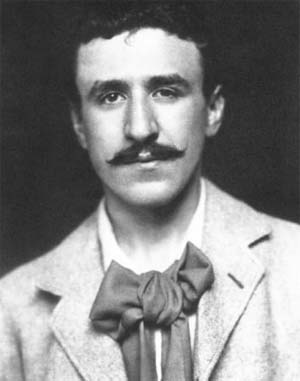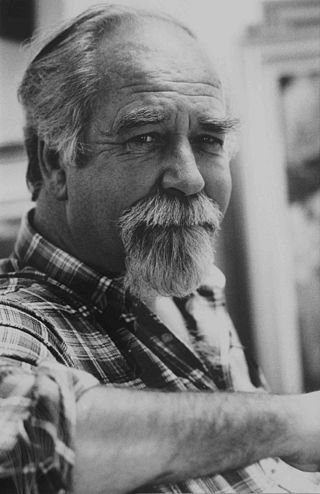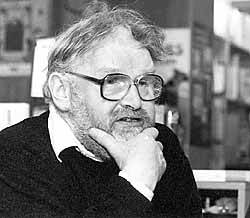Related Research Articles

Charles Rennie Mackintosh was a Scottish architect,designer,water colourist and artist. His artistic approach had much in common with European Symbolism. His work,alongside that of his wife Margaret Macdonald,was influential on European design movements such as Art Nouveau and Secessionism and praised by great modernists such as Josef Hoffmann. Mackintosh was born in Glasgow,Scotland and died in London,England. He is among the most important figures of Modern Style.
Jack Vettriano is a Scottish painter. His 1992 painting The Singing Butler became a best-selling image in Britain.

William Angus McIlvanney was a Scottish novelist,short story writer,and poet. He was known as Gus by friends and acquaintances. McIlvanney was a champion of gritty yet poetic literature;his works Laidlaw,The Papers of Tony Veitch,and Walking Wounded are all known for their portrayal of Glasgow in the 1970s. He is regarded as "the father of Tartan Noir" and as Scotland's Camus.
William Ferguson Miller MBE is a Scottish former professional football player and manager,who made a club record 560 league appearances for Aberdeen. Sir Alex Ferguson described Miller as "the best penalty box defender in the world".

David Michie OBE,RSA,PSSA,FRSA,RGI was a Scottish artist of international stature.
Steven Campbell (1953–2007) was a painter from Scotland.

Alasdair James Gray was a Scottish writer and artist. His first novel,Lanark (1981),is seen as a landmark of Scottish fiction. He published novels,short stories,plays,poetry and translations,and wrote on politics and the history of English and Scots literature. His works of fiction combine realism,fantasy,and science fiction with the use of his own typography and illustrations,and won several awards.
Fyffe William George Christie was a British figurative artist and mural painter. He served in the British Army during World War II as a bagpiper and stretcher bearer. He began painting during the war and attended the Glasgow School of Art from 1946 to 1951. After graduating,he began painting murals,including Christ Feeding the People (1950-1951) and various others in Glasgow,including one in the Glasgow University Union. Christie then moved to London,where he taught at various schools and continued painting.
James Wallace Ferguson was a Scottish painter,born in Stirling,and resident in Glasgow for most of his life. He went to the Glasgow School of Art before the First World War. He won the Guthrie Award in 1923 for young artists of the Royal Scottish Academy. He became the President of the Glasgow Art Club in the 1950s. He also was a Principal Lecturer in Art at Jordanhill Teacher Training College. He died in New Zealand while staying with his son.
David Shanks Ewart was a Scottish painter,born in Glasgow. He went to the Glasgow School of Art just after the First World War. He won the Guthrie Award in 1926 with his work The Toilers.
The Guthrie Award is awarded annually with few exceptions to at most two recipients by the Royal Scottish Academy and is one of the most prestigious art awards in Scotland. It is named after the artist James Guthrie.
Kate Campbell Muirhead was a Scottish sculptor,born in Perth. She won the first Guthrie Award in 1920 with her work,the portrait bust Elizabeth. As Muirhead got older she moved into painting rather than sculpture.
Gordon Stewart Cameron was a Scottish painter,born in Aberdeen,Scotland. He won the Guthrie Award in 1944 with his work,the painting Boy With Apple.
Sinclair Thomson was a Scottish painter,born in Glasgow,Scotland. He won the Guthrie Award in 1948 with his oil painting The White Shawl.
James Hillocks was a Scottish painter. He won the Guthrie Award in 1947 with his work,the oil painting Portrait Of My Mother. He went to teach art in Ghana.
Helen Adelaide Lamb was a Scottish artist known for her embroidery and paintings. She won the Lauder Prize in 1924,1931 and 1953.
Amelia Beattie Forsyth was a Scottish painter. She won the Lauder Prize in 1937.
Anne Knox Arthur was a Scottish artist and author,specialising in embroidery. She became Head of the Embroidery Department of the Glasgow School of Art in 1928. She won the Lauder Prize in 1939.
John Daniel Revel was an artist;and former Director of the Glasgow School of Art. He took the post of Director in 1925.
The Society of Eight was an artistic grouping of Scottish painters. The Society set up its own gallery space in Edinburgh to exhibit their work. It was founded in 1912 and last exhibited in 1938. The Society did not reform after the Second World War.
References
- 1 2 "Whiteman, John – Glasgow School of Art: Archives & Collections". gsaarchives.net.
- 1 2 "The Scotsman – Thursday, 17 January 1991" – via British Newspaper Archive.
- ↑ "Back Matter". Perspecta. 27: 212–217. 1992. JSTOR 1567185.
- 1 2 "The Scotsman – Thursday, 29 August 1991" – via British Newspaper Archive.
- ↑ "The Scotsman – Wednesday, 12 December 1990" – via British Newspaper Archive.
- 1 2 "The Scotsman – Saturday, 30 November 1991" – via British Newspaper Archive.